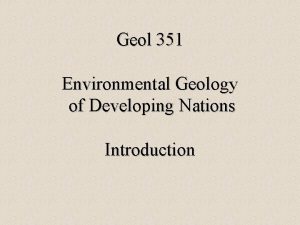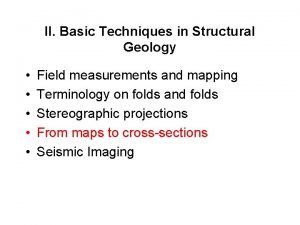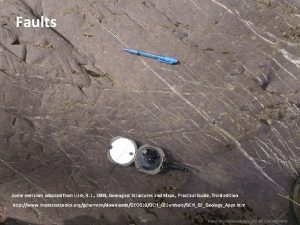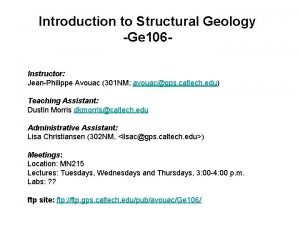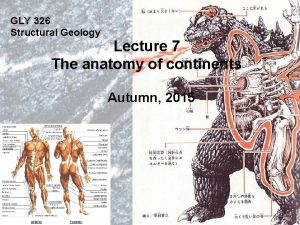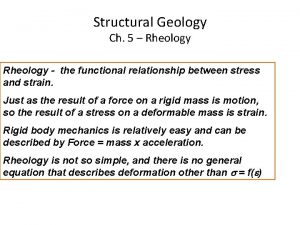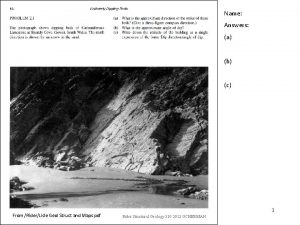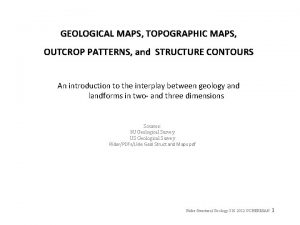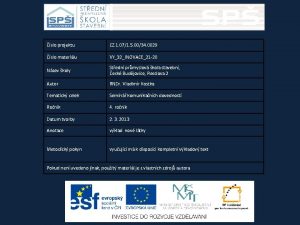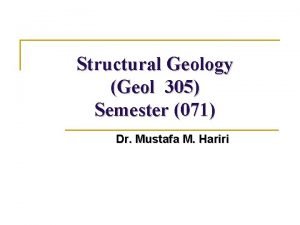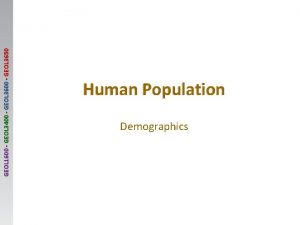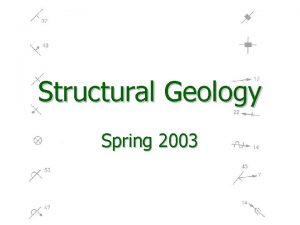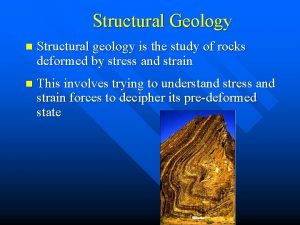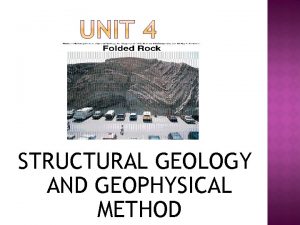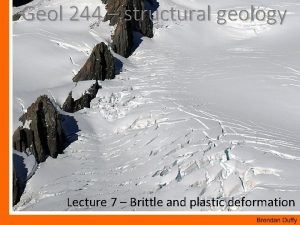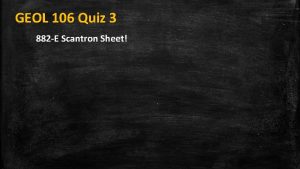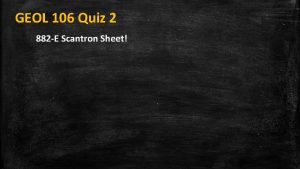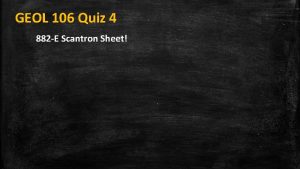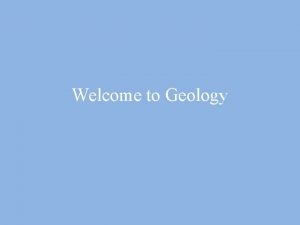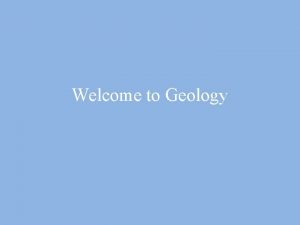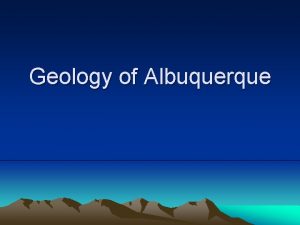Structural Geology Geol 305 Semester 071 Dr Mustafa




















- Slides: 20

Structural Geology (Geol 305) Semester (071) Dr. Mustafa M. Hariri

CLEAVAGE AND FOLIATIONS

CLEAVAGE A tendency to split along planes other than bedding. Cleavage is directly linked to other deformation processesespecially folding- and metamorphism. It can help in understanding the fold geometry and the physical conditions during deformation. It may serve as a conduit for ground water

Fabric Is used to describe the spatial and geometric relationships that make up the rock. It includes planar and linear structures-bedding, cleavage, and the orientation of minerals and their relationship to texture.

Slaty Cleavage Is a penetrative structure (occurs in all scale). It consists of parallel grains of thin layer silicates (clay minerals or micas) or thin anastomosing subparallel zones insoluble residues produced by pressure solution.

S-surfaces Planar and some curved structures in deformed rocks. They include all cleavages and foliations commonly though as penetrative structures. They also include nontectonic planar structure, bedding. In areas of multiple S-surfaces, a series of subscripts is assigned bedding being oldest is designated S 0, S 1 is the oldest cleavage (or foliation) and any later structures are given numerically higher subscripts.

Cleavage and Foliation can be divided into Continuous : Cut all the rock mass. Spaced: can be resolved into regions of uncleaved rock separated by cleavage planes spaced from less than a millimeters to several centimeters. The uncleaved zones between cleavage surfaces are called microlithons.

Spaced cleavage is divided into Disjunctive (cross-cutting and not related to original layering) Disjunctive cleavage may be divided into: styloitic anastomosing rough smooth p Crenulation (which crenulates preexisting layering) Crenulation cleavage may be divided into : discrete zonal p Spacing in the different types of cleavage: slaty cleavage (continuous) 0. 01 mm to less than 1. o mm crenulations cleavage 0. 1 mm to 3 cm Shale usually display more closely spaced cleavage compared to sandstone that shows wide space cleavage (Figs. 17 -4 and 17 -7)

Cleavage types Pressure solution produces spaced cleavage by dissolving the most soluble parts of a rock mass leaving behind discrete insoluble residues in irregular planar zones that define cleavage (Fig. 17 -8). Spacing of pressure solution ranges from less than a millimeter to more than a centimeter. They may be irregular ( styloitic to anastomsing to rough) to smooth, where rock mass is more severely deformed. Slaty cleavage is a planar tectonic structure resulting from parallel orientation of clays, muscovite, and or chlorite. It is penetrative and develop generally in rocks of fine-grained sedimentary and volcanic rocks, such as shale, mudstone, siltstone, and tuff. FORMATION OF SLATY CLEAVAGE: Folding, Compression, Pressure solution, recrystalliztion and pure and simple shears concepts.

Cleavage types Crenulation cleavage marked by small-scale crinkling or crenulation. Most crinkles are spaced and asymmetric, and the short limb becomes usually the cleavage plane. They commonly form by deformation of an earlier cleavage or bedding. Foliation foliation is a term used to describe all type of cleavage slaty, crenulation and it is used also to describe the planar structure in coarser-grained metamorphic rocks, such as schist and gneiss where planar orientation of at least one mineral dominates the fabric (parallel of mica, amphibole, and flatten of quartz grains). Schistosity refers to foliation in schistose. Foliation is easily recognized if there is an alternate of quartz and feldspars with mica and amphibole.

Cleavage types Metamorphic differentiation: formation of new layering by recrystallization or pressure solution. It is the production of new minerals with new orientation Differential layering the foliation that is produced during metamorphism and recrystallization. At high temperature and pressure this process will be enhanced with processes and gniessic banding may be produced. Crenulations and spaced slaty cleavage may produce differential layering at low temperature and pressure.

CLEAVAGE BEDDING RELATIONSHIP The angular relationship between cleavage and bedding can be used to determine whether one is observing the upright or the overturned limb of a fold. If bedding dips less steeply (lower angle but same direction as cleavage) the rock will be on upright limb. Care should be taken regarding the fold axis and timing of cleavage.

CLEAVAGE REFRACTION Refraction of cleavage from layer to layer occurs where the texture and composition-ductility- vary from layer to layer in rocks. The angle between cleavage and bedding changes or refracts as the cleavage passes from one layer to another (Fig. 1716) p Most slaty cleavage forms parallel to axial surfaces in folds but may be displaced or fanned with respect to the hinge as folding proceeds (Fig. 17 -17) p

LINEAR STRUCTURES Any structure that can be expressed as a real or imaginary line is linear structure or lineation. Lineament is a topographic feature consisting of straight or aligned surficial features such as valleys and ridges.

Non-penetrative linear structures: Slickenlines: are the direct result of frictional sliding. Slinckensides: refer to the entire movement surface develop on the fault surface, bedding, and foliation. Slinkenfibers: fibrous crystals of calcite, quartz, chlorite or iron oxides where their long axes are oriented in the direction of movement.

Penetrative linear structures: Intersection lineation (two cleavage or foliation planes) Mineral lineation (alignment of grain aggregates of mica, amphibole or feldspars) Pressure shadow: of quartz, muscovite, chlorite, magnetite on either side of single crystal of pyrite Rotated minerals Rods: rodding or grain aggregates of one or more minerals such as quartz, feldspars and mica (it is common in ductile shear zones) Natural strain ellipsoids : long axes of pebbles, boulders, vesicles and reduction spots. Mullions: form at boundaries between differing rock types. Boudinage: consists of lenticular segments of layer that has been pulled apart and flattened (layer been segmented is less ductile than enclosing). Shape of boudins is affected by the degree of contrast between the two rocks. Large contrast produces boudins with sharp edges, and small contrast produces rounded boudins. Boudins can produce under conditions of either ductile or brittle. Under brittle condition most boudins are angler and space between them is filled with less-competent rock

Type of Boudins 1) Ordinary boudinage: consists of segmented, sausage shaped of a single layer in which the lenticular segments parallel one another. It results from extension of the layer in a single direction. 2) Chocolate-block (chocolate tablet) boudinage: It is produced if layer-parallel extension has occurred in two directions, the resulting boudinage consists of a series of threedimensional blocks.

Importance of Boudins p p p They yield information about strain, shear sense and difference in competence. The neck line of the boudin is the lineation and is commonly oriented parallel to the fold axes. Boundinage is frequently seen in the limbs of the folds, where most flattening and layer-parallel extension occurs.

LINEATION AS SHEAR-SENSE INDICATORS p p Slickensides directly indicate movement sense by the direction of their lines and steps. Boudins indicate the extension direction. Mineral lineations yields sense of shear if the linear mineral is segmented in the movement direction. Rotated minerals are shearsense indicators-the direction of movement is perpendicular to the lineation (rotation axis)

FOLDS AND LINEATIONS p p Intersection lineations tend to parallel fold axes. Mullions and Boudin necks generally parallel the fold axes. Mineral-elongation lineations sometimes parallel fold axes and are sometimes oriented oblique to normal to fold axes. Deformed lineations are strain markers that can help to reveal the later deformation.
 Geology 351
Geology 351 Settelünke geol
Settelünke geol Busk method
Busk method Structural geology
Structural geology Structural geology
Structural geology Stereographic projection structural geology
Stereographic projection structural geology Structural geology
Structural geology Structural geology
Structural geology Horizontal name
Horizontal name Outcrop pattern
Outcrop pattern 071 atm code
071 atm code 071-com-0804
071-com-0804 Noise light and litter discipline blc
Noise light and litter discipline blc 071-com-0029
071-com-0029 Foo2123
Foo2123 Hello
Hello 071-com-4407
071-com-4407 N 3^071
N 3^071 Terrain features on a military map
Terrain features on a military map ?3305501049 0000 28|.|091 27|.|071 98|.|553 102|.|311 13`
?3305501049 0000 28|.|091 27|.|071 98|.|553 102|.|311 13` React to indirect fire powerpoint
React to indirect fire powerpoint
